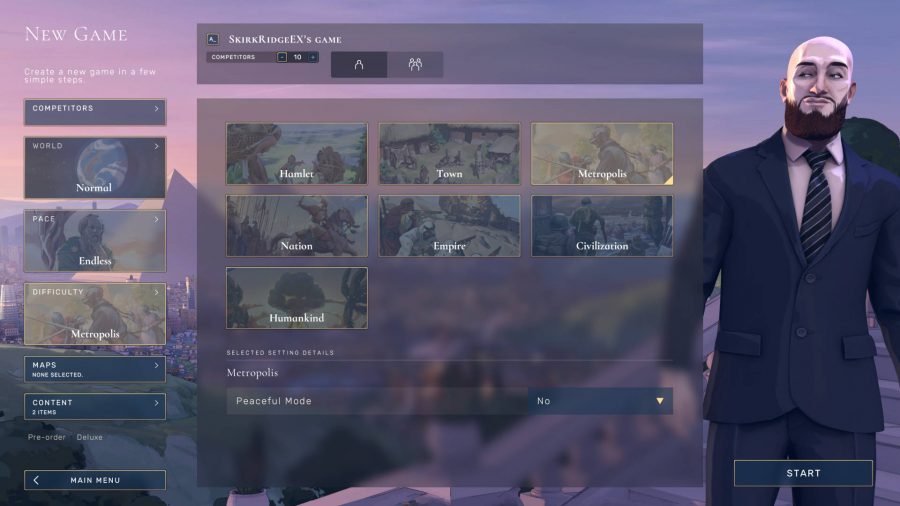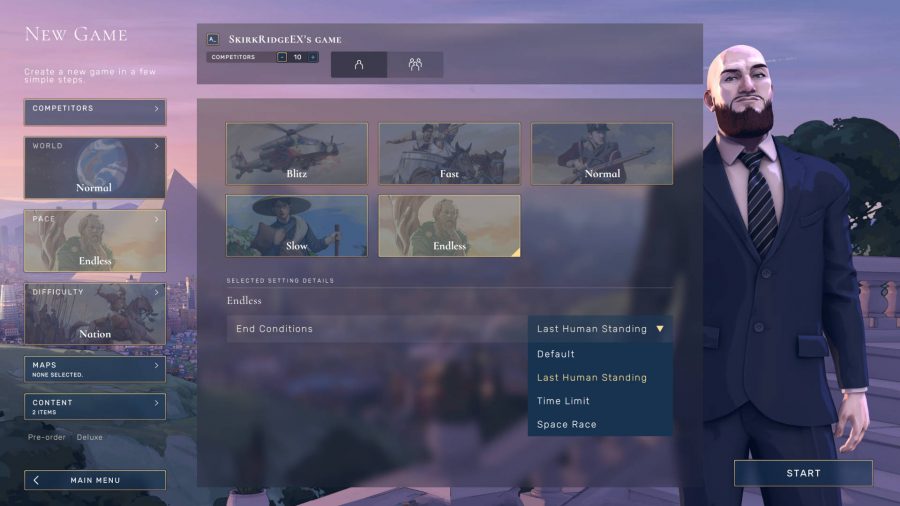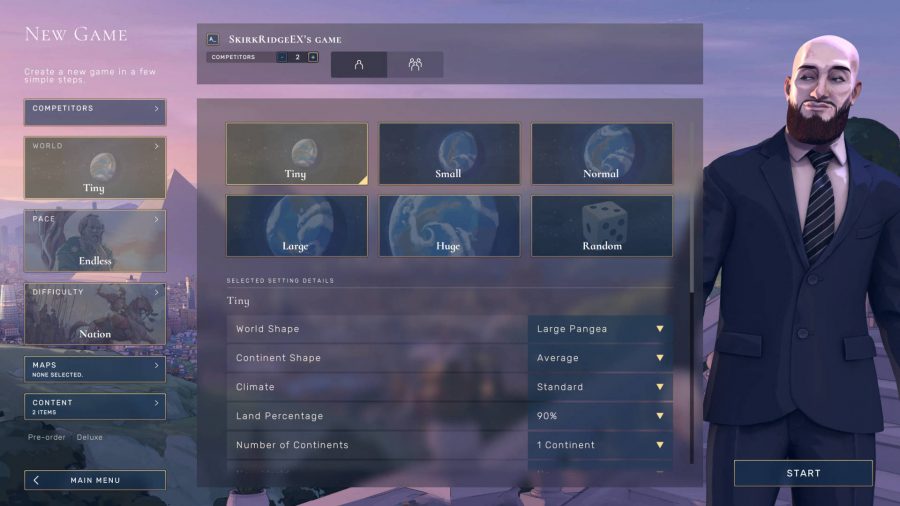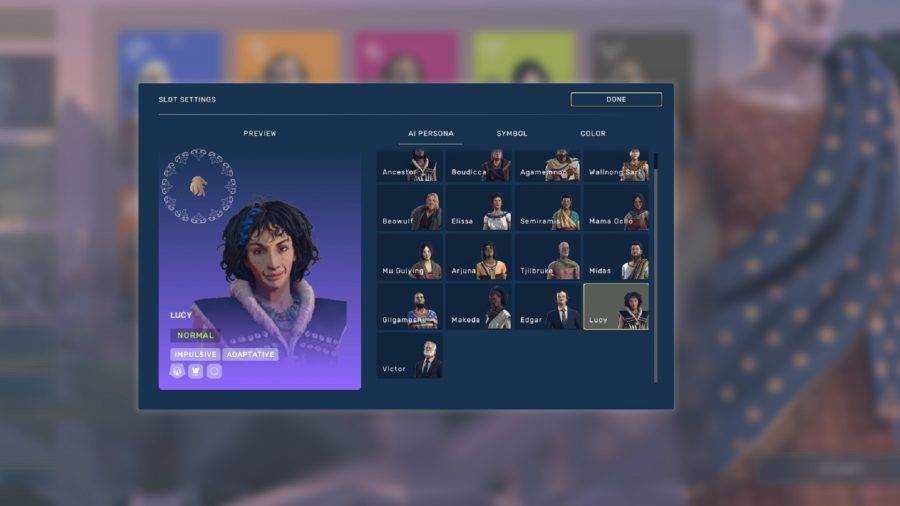Want to know about every difficulty setting in Humankind? Before you even start the new Civilization-like strategy game, you have a whole list of options that determine how hard the game is. There are four different tabs in the menu, each of which influences the game’s overall difficulty in some way, shape, or form.
You have a bit of freedom to change everything about the world that’s generated and the other cultures on the map. AI opponents will have their own persona, which will determine how aggressive they are. Some may wish to send armies at you, so you should brush up on battle tactics if you spot them roaming around your borders.
There’s also settings for changing how the world is generated, how many turns your game will have, and the general difficulty of the game itself. We will go over every single one of these game setting tabs in order so you know which one of Humankind’s difficulty settings you should pay attention to if you want to make the game easier, or harder.
Humankind Difficulty settings
The is the most obvious section for setting difficulty is called ‘difficulty’, and is last on the list of four sections during game setup. You also have an option underneath all of the settings for whether you want to turn ‘Peaceful mode’ on or off.
This sets the level of aggression of the enemy forces that each of the AI controls. Here are all of the Humankind difficulty settings:
- Hamlet – very easy
- Town – easy
- Metropolis – normal
- Nation – hard
- Empire – seriously difficult
- Civilization – an impossible challenge
- Humankind – the ultimate challenge
Competitors
This is where you can not only set up the number of opponents in your game, but also how many of them are controlled by humans or the AI. The maximum number of players in any game is dependent on the size of the map. Tiny worlds only serve up to three players and small worlds can support up to six. Any world size that’s normal, large, or huge can be home to a maximum of ten players.
If you click the button to invite other players, you’ll be able to toggle the privacy settings so you control who joins your game, whether you’re allowing spectators to watch, and even send your Lobby ID for those who you want to join.
For those who are looking to play in single-player, there are 16 Humankind AI personas. Each one has their own biases and strengths that affect their overall challenge – separate from other difficulty settings. AI opponents are sorted into normal, advanced, and expert difficulties.
Pace
Another difficulty factor is to do with the game’s pace. The winner of a game is the civilisation with the highest fame score, and there are several different ways a game can end. Note that ‘ending’ and ‘winning’ are not the same thing, but in this section you can choose which end conditions are in effect.
Changing the game’s pace can determine how much time you have in order to achieve the overall goal of earning the most fame points. Here are all of the game pace settings:
- Blitz – 75 turn limit
- Fast – 150 turn limit
- Normal – 300 turn limit
- Slow – 450 turn limit
- Endless – no turn limit
Humankind World options
This section is for determining the game map. It doesn’t directly relate to difficulty as much as the above options, but depending on what kind of world you setup may affect your ability to do certain things, which can make things difficult depending on how your game pans out.
Here are all of the Humankind world modifiers and how each one affects the game map generation:
World size
Here are all of the world sizes and their different limits:
- Tiny – for two to three players, size is roughly 60×35 hexagons. The maximum different luxury resources is six and maximum number of continents is four
- Small – for up to six players, size is roughly 80×50 hexagons. The maximum different luxury resources is ten
- Normal – size is roughly 95×55 hexagons. The maximum different luxury resources is 13
- Large – size is roughly 130×75 hexagons. The maximum different luxury resources is 17
- Huge – size is roughly 150×88 hexagons. All luxury resources are available
World Shape
This affects the overall land that you build your settlements on, and also the shape of the landmass. You can also make a custom world shape by clicking on Custom. The pre-set options are:
- Pangea – the world has a single landmass in a vast ocean
- Large Pangea – the world has a single, large landmass in a small ocean
- Few Continents – the world has a few continents. The number is randomly determined at the game’s start
- No Ocean – the world has one unending landmass
- 2 Continents – the world has two landmassses in a vast ocean
- 4 Continents – the world has four landmasses in a vast ocean
- Random – the world will be chosen randomly
Continent Shape
This is for the shape of each continent in your game, so it doesn’t apply if No Ocean was selected for the world shape. Aside from customising your own, your options here are:
- Regular – the continent is more rounded or curved in shape. There are no internal seas or great altitude changes
- Average – there are some higher cliffs and internal seas are more possible
- Chaotic – there can be internal seas, highly deformed continent shapes, and a great deal of randomness in altitudes. Distances between continents and their sizes can also vary greatly
Climate
The game describes this option as settings for determining the temperature and the humidity of your world. In practice, this just determines which type of land you’re most likely to see in your world. There are a lot of options here to choose from:
- Hot – savannas
- Hot and Dry – rocky fields and deserts
- Hot and Wet – forests and jungles
- Cold – tundras
- Cold and Dry – snow and rocks
- Cold and Wet – taigas and ice
- Dry – rocks
- Wet – forests
- Standard – the world climate will be varied and containing multiple different environments
Land Percentage
This option covers the percent of the surface area of the game map that is land, with the availability of some of the options listed determined by the world size. It can go from as low as 10% land to as high as 100%.
Number of Continents
You can use this option to manually determine how many continents appear on your game map. This number can go from as low as one continent to as many as eight.
You can also select the option to randomise the number of continents, or have the AI choose the number of continents at random between 2-4 and 3-5 continents.
New World
This option allows you to enable the presence of a distant continent at the start of the game that has no empire.
Islands Odds
Determines the odds of if islands are generated in-game and how many will be present. Your options are between Few, Some, Standard, Many, and Random.
World Wrap
Toggles between allowing units to warp to the other side of the planet if they reach the end of the map.
Hemispheres
You can use this option to toggle between having both poles, only the North Pole, or only the South Pole active. This determines the relative warmth of the poles on the map.
World Generation Seed
If you leave this empty, you can generate a random seed. However, if you type in a code here you can get a specific seed to generate instead.
Continent Spread
Determines the distance between continents. Regular keeps the continents equidistant, while Chaotic varies up the closeness of the different continents.
Continent Form
Regular makes all the continents have a uniform shape, while Chaotic has all continents have elongated and irregular shapes. Random changes the islands differently for each island separately.
Lake Odds
Determines the odds of if lakes are generated in-game and how many will be present. Your options are between Few, Some, Standard, Many, and Random.
Lake Size
Determines the size of lakes that are generated. These can range from small, medium, large, or a random size per lake.
Rivers
Determines the odds of if rivers are generated in-game and how many will be present. Your options are between Few, Some, Standard, Many, and Random.
Ridges and Cliffs
Determines the odds of if ridges or cliffs are generated in-game and how many will be present. Your options are between Few, Some, Standard, Many, and Random.
Elevation
Determines the elevation of your world map. Flat means there are no mountains to get in the way of building on your territory. It also allows you to march your troops across long distances. Steep ensures there are tons of hills and mountains to affect your movement and places to build on. Standard is a mix of flat and steep surfaces, while random chooses the continent type for each landmass.
And those are all of the Humankind difficulty settings. There’s a lot to take in, but thankfully you only need to do this every time you start a new game. In the meantime, check out our guide to Humankind cultures.
{“schema”:{“page”:{“content”:{“headline”:”Humankind difficulty settings and game options”,”type”:”guide”,”category”:”humankind”},”user”:{“loginstatus”:false},”game”:{“publisher”:”Sega”,”genre”:”Strategy Gamer”,”title”:”Humankind”,”genres”:[“Strategy Gamer”,”Simulation”]}}}}





